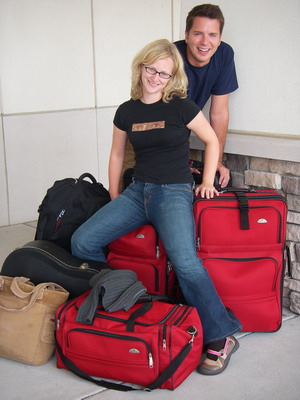As part of his campaign to change the national Thanksgiving dish from turkey to spaghetti carbonara, Calvin Trillin has reasoned that the primary reason Americans don’t eat turkey more often is that it’s not very good. One might argue, though, that this is a “turkey and egg” kind of issue. If Americans don’t eat turkey more frequently because they don’t really like it, it may be because they don’t know how to cook it well because they don’t eat it very often because they don’t really like it because they don’t know how to cook it well ... or, on the other hand, it might just be an uninspiring entree. Still, we as a nation persevere and, despite last year’s dry, tasteless breast meat, we will roast another bird and we will try a new recipe and we will hope. Perhaps it is for this very process – a testament to the ingenuity, resolve and eternal optimism of the American spirit – that we return to the turkey year after year.
And there is no shortage of new recipes for preparing your Thanksgiving bird. While in New Orleans at the height of the deep frying craze, Tam was privileged to taste two turkeys that had been injected with no less than six quarts (!) of seasoning each before their dip in a barrel of bubbling oil. (This was a major undertaking, and it did yield deliciously juicy meat and crispy, finger-licking-good skin.) His mom says that for years when she was first married, she would put on her heat-proof oven gloves and, with considerable physical effort, flip her hot, half-roasted turkey upside down midway through the cooking process to better distribute the juices, always being careful not to let the stuffing fall out! To baste or not to baste? Sausage or chestnuts? Stuffing or dressing? Wouldn’t you rather just have salmon?
And it's not just turkey! Another standard item on the Thanksgiving menu, cranberry sauce, has always been a particular bane of Laura's. She has attempted to make it many times, and has - without fail - met with some kind of disaster. Her first cranberry catastrophe came when she was inspired to make Mother Stamberg's Cranberry Sauce, a recipe which NPR correspondent Susan Stamberg has, with the permission of her mother-in-law Marjorie, broadcast nationally on Thanksgiving day every year since 1971. How could something so renowned fail to please? Laura was unfazed by the inclusion of such ingredients as raw onion and horseradish and the idiosyncractic technique of freezing the ingredients together and then serving the sauce only partially thawed. She persevered, followed Mother Stamberg's instructions faithfully and carefully, and ended up with something that looked like a chunky variety of Pepto-Bismol, and tasted like something that would cause you to reach for the real thing. A second disaster came when we hosted Thanksgiving dinner at our tiny apartment in New Haven a couple of years ago, squeezing twelve friends and relatives around an expanded table in our miniscule study. (Tam had to sneak into work and secretly borrow chairs from his closed office to provide seating for everyone.) The pre-dinner oysters on the half shell were fabulous; the stuffing was delectable; even the turkey was quite succulent. But the cranberry sauce! Laura misread the amount of fresh parsley that went into it; by the time she realized her error, the sauce was more green than red. We spent the next twenty minutes attempting to remove chopped parsley from the sauce with spoons and our hands (not, by the way, an easy task, and made no easier by Tam's periodic fits of the giggles as he looked at the growing pile of sodden chopped parsley on the cutting board), but even with all our efforts, the sauce looked like a premature celebration of Christmas and tasted like an entire cranberry bush ground up into little pieces.
A second disaster came when we hosted Thanksgiving dinner at our tiny apartment in New Haven a couple of years ago, squeezing twelve friends and relatives around an expanded table in our miniscule study. (Tam had to sneak into work and secretly borrow chairs from his closed office to provide seating for everyone.) The pre-dinner oysters on the half shell were fabulous; the stuffing was delectable; even the turkey was quite succulent. But the cranberry sauce! Laura misread the amount of fresh parsley that went into it; by the time she realized her error, the sauce was more green than red. We spent the next twenty minutes attempting to remove chopped parsley from the sauce with spoons and our hands (not, by the way, an easy task, and made no easier by Tam's periodic fits of the giggles as he looked at the growing pile of sodden chopped parsley on the cutting board), but even with all our efforts, the sauce looked like a premature celebration of Christmas and tasted like an entire cranberry bush ground up into little pieces.
The cranberry sauce curse continued on Saturday, when we served a Thanksgiving-inspired meal to some London friends. No turkey, but pork chops, potatoes mashed with squash and roasted garlic, cornbread and green beans. And cranberry sauce, which was pretty good until Laura was inspired to add some orange zest at the last minute ... way too much orange zest, resulting in a sauce that appeared to be the appropriate shade of glossy dark red but tasted like nothing so much as warm orange juice concentrate. This year, as newlywed Americans away from home, we’re not feeling the need to produce a giant turkey dinner for two. Of course, we miss our families and will be thinking of them on this day, but it can't be denied that there is a certain freedom in shaking off the mantle of tradition when you’re abroad. We don't need to fret about lumps in the gravy. Except for the purposes of entertaining blogging, there’s no reason to scour the city for canned pumpkin pie filling or fresh cranberries. The two of us couldn't possible finish off even the smallest turkey, which would be nearly impossible to cook in our tiny oven anyway. What to do instead?
This year, as newlywed Americans away from home, we’re not feeling the need to produce a giant turkey dinner for two. Of course, we miss our families and will be thinking of them on this day, but it can't be denied that there is a certain freedom in shaking off the mantle of tradition when you’re abroad. We don't need to fret about lumps in the gravy. Except for the purposes of entertaining blogging, there’s no reason to scour the city for canned pumpkin pie filling or fresh cranberries. The two of us couldn't possible finish off even the smallest turkey, which would be nearly impossible to cook in our tiny oven anyway. What to do instead?
In planning the day, our thoughts did turn at least briefly to the Pilgrim Fathers and their fateful journey in 1620 from Plymouth in Devonshire to the New World. In 1926, the ultra-excitable British travel writer H.V. Morton noted, “The sailing of the Mayflower was one of the most dramatic events of the last three hundred years. Think how much was storing up for the world when that little ship went Westward Ho!” Indeed.
Inspired by his enthusiasm, we pondered a trip to Plymouth to pay our respects but opted instead to celebrate in an unconventional manner by checking out what the Pilgrims were in such a hurry to put behind them, at the new British galleries in the Victoria & Albert Museum. These collections feature such splendid possessions as the Great Bed of Ware, the copes and collars of the Henries VII and VIII, and the platters, bowls and posset pots from which the feasts of Olde Englande were served. (Posset was a hot drink of curdled milk, popular in the seventeenth and eighteenth centuries, that was drunk from traditional pots that resembled small decorative teapots with the pipe or spout used like a straw. It was sometimes drunk for medicinal purposes, and these posset pots were often given as gifts to new mothers who would drink posset after childbirth for its restorative qualities.)
 We ended the day with a completely turkey-free meal at a lovely neighborhood French restaurant (wouldn't Art Buchwald be proud?), the Brackenbury in Hammersmith. The spread included cauliflower soup with roasted almonds; mushroom pappardelle with shaved autumn truffles; duck confit with roasted pumpkin and cannellini beans; roasted cod with mussels and corn chowder, bacon and fennel; and, we are delighted to report, lemon posset with raspberry coulis and shortbread! While the food was unorthodox Thanksgiving fare, the quantity in which we consumed it was fully in line with tradition.
We ended the day with a completely turkey-free meal at a lovely neighborhood French restaurant (wouldn't Art Buchwald be proud?), the Brackenbury in Hammersmith. The spread included cauliflower soup with roasted almonds; mushroom pappardelle with shaved autumn truffles; duck confit with roasted pumpkin and cannellini beans; roasted cod with mussels and corn chowder, bacon and fennel; and, we are delighted to report, lemon posset with raspberry coulis and shortbread! While the food was unorthodox Thanksgiving fare, the quantity in which we consumed it was fully in line with tradition.
Next year, we will happily return to the turkey-and-stuffing routine; and we've made the life-changing decision to shift the cranberry sauce duties to Auntie Janet.
Happy Thanksgiving!




1 comment:
Yay for the Great Bed of Ware! I grew up in Ware and the Great Bed is our sole claim to fame - apart from the stupid name, of course ('you come from WHERE?' 'yes...'). Lovely to meet you at Johanna's today - gorgeous cookies!
Post a Comment